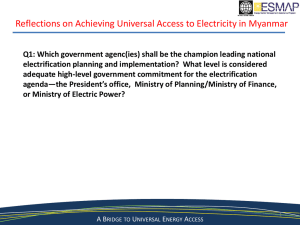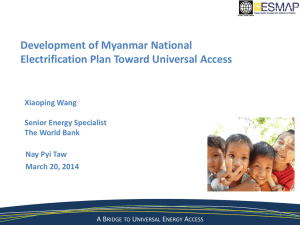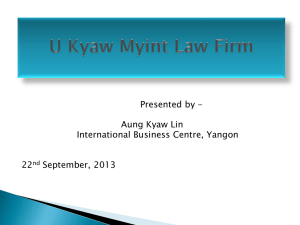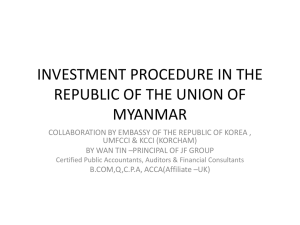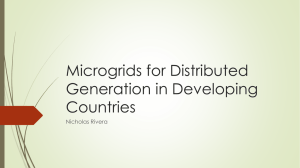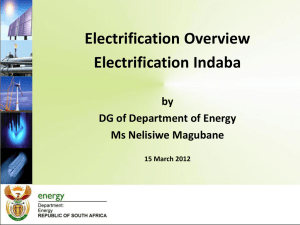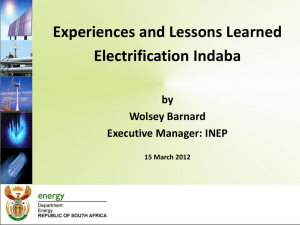1_Myanmar_NEP_overview_9-12-2014x
advertisement
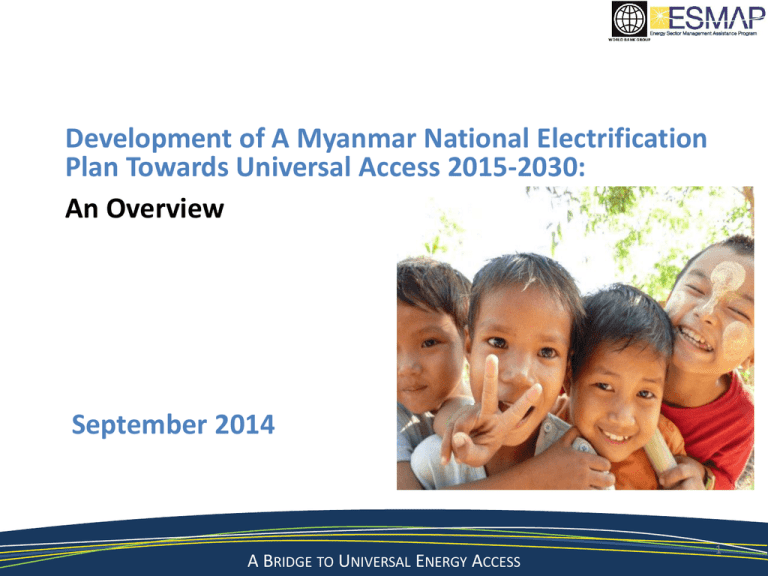
Development of A Myanmar National Electrification Plan Towards Universal Access 2015-2030: An Overview September 2014 A BRIDGE TO UNIVERSAL ENERGY ACCESS 1 Workshop Agenda Objective of this workshop Why universal access? Is universal access by 2030 achievable in Myanmar? (Section 1) How can universal access be achieved in Myanmar: Introduction of a strategic national electrification plan (NEP)? (Sections 2-4) How can DPs contribute to NEP implementation? (Sections 5-8) Discussions and Q&As A BRIDGE TO UNIVERSAL ENERGY ACCESS 2 Electrification and Socioeconomic Development A BRIDGE TO UNIVERSAL ENERGY ACCESS 3 Electrification Rate Increased Rapidly in Vietnam Between 1993-2011 2011 2004 100% 90% 1997 80% 70% 60% 50% 40% 1993 1986 30% 20% 2.5 10% 0% 1976 1986 1996 2006 Laos also Made Rapid Progress in Electrification Since 1995 80% Access to Electricity 2014 70% 60% 50% 40% 30% 20% 10% 15% 1995 0% 1995 1996 1997 1998 1999 2000 2001 2002 2003 2004 2005 2006 2007 A BRIDGE TO UNIVERSAL ENERGY ACCESS 2008 2009 2010 2011 5 Asian Countries Saw Rapid Increase in Electrification Rate at Relatively Low GDP Level A BRIDGE TO UNIVERSAL ENERGY ACCESS 6 Is universal access by 2030 achievable in Myanmar? 7 Government of Myanmar is Strongly Committed to Achieving Universal Access to Electricity • Goal to achieve > 50% coverage in 2016 - The Government is developing an implementation plan to increase electricity coverage in 2016. • The President’s office has established a dedicated National Electrification Executive Committee under the patronage of the Vice President, and with union ministers of MOEP and MLFRD as chair and co-chair respectively. • Renewable Energy for Rural Electrification - A Rural Electrification and Potable Water Resource Committee was established where one of the mandates is to promote renewable energy for rural electrification. A BRIDGE TO UNIVERSAL ENERGY ACCESS 8 Government Commitment to Universal Access Aligns with UN Sustainable Energy for ALL (SE4ALL) Objectives • Myanmar and SE4LL - Myanmar endorsed the UN SE4ALL Initiative, a goal to ensure universal access to modern energy services by 2030, co-led by the UN Secretary General and the President of the World Bank. • Myanmar an high impact country - Myanmar is identified as one of the high impact countries that offer the most potential to make rapid progress by SE4ALL. • Myanmar is one of the first countries, and currently the only country in the East Asia and Pacific Region, to receive significant grant support (approximately $2 million) from the World Bank/ESMAP SE4ALL Technical Assistance Program. A BRIDGE TO UNIVERSAL ENERGY ACCESS 9 But Myanmar’s electrification challenge is immense… The electrification rate is estimated at 33%... 2x New household connections per year Need to connect over as many households per year to reach universal electrification by 2030… 440,000 ESE YESB 189,000 Require d 130,000 59,000 2012 Source: MOEP (2011-2012), ESE, YESB data and Castalia estimations Assumes 6.5 people in a household For universal electrification by 2030 10 It is impossible to meet this challenge without a programmatic, sector-wide approach… Countries that have achieved rapid electrification have relied on Programmatic, Sector-wide approach Governmen t Key Features : Developmen t Partners Consumers Coordinated least-cost technical and investment planning Sustainable financing policy Stable flow of funds Results focused Private Stakeholder s Stakeholders Sector Ministries Regulatory Authority Local Governmen t 11 Utility Myanmar National Electrification Plan (NEP) 2015-30 • NEP should be a comprehensive action plan for developing, financing, and implementing electricity access scale-up program nationwide, with the target of achieving universal access by 2030. • NEP would align support from different stakeholders with the implementation program for achieving national access targets and syndicates financing on a timely, ongoing and programmatic basis. A BRIDGE TO UNIVERSAL ENERGY ACCESS 12 Component I: Geospatial Least Cost Electrification Rollout Plan A high level geospatial rollout plan comprising: • • Systematic grid network rollout connection plan Complementary spatial plans for mini-grids and individual systems A BRIDGE TO UNIVERSAL ENERGY ACCESS 13 Component II: Road Map and Investment Prospectus • Long-term and intermediate targets for 2015-2030 • Investment financing framework for the first 5 years • Action plan to address enabling policy and institutional framework • Capacity strengthening initiatives for key institutions and agencies 2030 2025 2014 2015 2020 2020 ? 100% ? ? ? 33% A BRIDGE TO UNIVERSAL ENERGY ACCESS 14 Processes and Milestones First Mission/ Workshop May 2013 Second Mission/ Workshop November 2013 Activities - Establish dialogue with Govt & other stakeholders - Share international experience -Discuss methodology and work plan -Continue dialogue with stakeholders Outputs - Agree on the need of an NEP and key work areas - Agree on methodology, milestones, and working arrangements - Develop scope of work - Hire consultants - Develop methodology and work plan - Continue data collection - Interim results for Kayin and Chin States Follow-on Work Third Mission/ Workshop March 2014 -Present and discuss interim results -Agree on institutional framework options - Feedback on geospatial plan and IP - Complete draft NEP A BRIDGE TO UNIVERSAL ENERGY ACCESS Fourth Mission/ Workshop Sep 2014 - Present draft final NEP - Present investment opportunities - Govt commitment to NEP adoption & implementation - Link financiers w/ investment opportunities - Finalize NEP - Transfer data and training - Govt adopts NEP 15 Implementation Arrangements • MOEP and MLFRD jointly lead the NEP preparation with participation from other member agencies of NEMC and REPWSC and assistance from the World Bank. • MOEP and MLFRD co-manage consultants together with World Bank. This includes strategic guidance to data collection, review of key deliverables, organization of workshops and study tours. • Consultants work closely with the government teams throughout the NEP preparation process • Close coordination with ADB, JICA and other DPs on respective, related initiatives. A BRIDGE TO UNIVERSAL ENERGY ACCESS 16 Consultant Teams Two consulting firms were competitively selected to assist in NEP development: •Columbia University — Geospatial least cost electrification rollout plan, with experience in Indonesia, Kenya, Nigeria, Tanzania, etc. •Castalia – Roadmap and Investment Prospectus, with experience in Indonesia, Rwanda, Kenya, Vanuatu A BRIDGE TO UNIVERSAL ENERGY ACCESS 17 Thank You A BRIDGE TO UNIVERSAL ENERGY ACCESS 18
